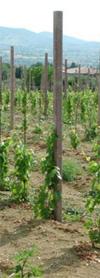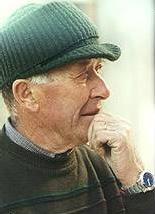From the hills of Montefalco in Umbria, the Bea family has been quietly toiling to create one of the most distinctive red wines we've had this year.
Though they have their own specific formula dating back hundreds of years, the major focus of making this incredible wine is letting nature take its course.
When Paolo says, "nature should be observed, heard, understood, not dominated," it is neither for political reasons nor for show - it's ultimately all about taste.
The family's goal is to achieve a natural expression of terroir & grape that extracts a liveliness and purity often lacking in over-manipulated wines.
Each Bea bottling reads "che il vino � vivo!" (this wine is alive!), and it is clear that they mean it from their uncanny ability to coax change from grapes without dominating or destroying their essence. While some ridicule their methods, such as planting artichokes under the vines to improve exhausted soil, it is just this type of active and delicate vigilance that makes their minimalist intervention practices so successful.
The result of the family's devotion is that the Bea name is uttered by those in the know in the same breath with DRC, Comtes Lafon, Dagueneau, and Gravner.
So why haven't you heard of Bea?
Like our email on Clos Rougeard last week, this is another family that has absolutely no desire to market themselves, but prefers to make only the amount of wine they know they can sell.
In fact, the Bea estate is 40 acres, less than 1/3rd of which are dedicated to wine production, while the rest is used for the family farm ... if they wanted to expand production, they would have no problem planting more vines.
How does the wine taste?
"Multifaceted" doesn't even begin to describe the outcome the Bea family achieves from their efforts. See our tasting notes below, but Bea's masterpieces will bring a smile to the faces of all Rhone, Brunello, and Amarone devotees. Staunch USA-only drinkers will have their world rocked.
2001 Sagrantino di Montefalco
Secco "Pagliaro"
Neal Rosenthal, the importer, says that the 2001 is the "fourth in a series of stunning vintages in Umbria and may perhaps be the finest of all."
We agree, because this 100% Sagrantino from the Pagliaro vineyard site is incredibly forward compared to previous vintages. While the wine will certainly improve over the next 10 years+ as it develops secondary nuances, it is drinking amazingly well right now.
Here are my tasting notes:
"The bouquet and palate are a beautiful mash-up of leather, tobacco, cheese, violets, plum, black cherries, funk, and a 'sauvage' earthy sweetness. Every time I smell or taste the wine, I get something new! While smooth in the mouth, some serious tannins lie in wait for the finish. Balancing this formidable structure is an impressively crisp acidity that pulls the whole thing together, keeping it vibrant and fresh. Somehow, despite its richness, the wine is ethereally light on the palate. This is the best red wine I have tasted so far in 2006, and the wine I would cellar if I were forced to pick only one"
2002 "Rosso di Veo"

The challenging 2002 vintage shows that the Bea's tried and true winemaking formula includes a healthy dose of good humor, as the first words on the label are "vendemmia difficile" (difficult year!).
The vintage also shows the magic that an incredible winemaker with patience and character can create by working with what nature offers. Appropriately, the words on the label that follow "difficult year" are "ma sorprendente" (but amazing).
How did Bea get amazing wine in a so-so vintage? By refusing to bottle his flagship wine (the "Pagliaro,") by discarding any questionable fruit and cutting overall production by 25% overall, by working with nature gave him to make the absolute best wine possible, and by humbly labeling his effort as a Vino di Tavola (the only criteria for which is that the wine is made in Italy).
Bea bottled only a single cuvee in 2002, blending all of the Sagrantino he normally uses for his top wine with the Sangiovese and Montepulciano d'Abruzzo used for his Montefalco Rosso.
The results are quite impressive - the Roso di Veo or "red of Bea" (Veo = Bea in local dialect), has outstanding density and concentration of flavor regardless of the year it was produced.
In comparison to the "Pagliaro" it also has a riper fruit character (surprising given the weather conditions) and is much darker in essence ... a sort of meat plus chocolate and dark fruit flavor combined with an earthy sweetness.
While the Rosso di Veo doesn't have the structure of the flagship Sagrantino, at 25% of the price it is made for joyous and immediate celebration today either on its own or with food.
More about the family

Members of the Bea clan have been living in the hills of Montefalco since 1500.
Since they moved into the area, little has changed at their classic, self-sustaining Italian fattoria. Known primarily for their wine, the Beas also farm olives, fruits and vegetables and raise livestock for their personal consumption ... all the while passing along history and tradition as well as a true passion for living in harmony with the land.
Paolo Bea, the head of the family, is nearing 75 years of age, but continues to be the guiding force at the winery, translating years of experience and lessons from his father into some outrageous wines. His son Giuseppe grows the grapes while Giampiero makes runs the winery from vinification, to bottling, to sales
What does natural wine mean?
A common misconception is that "natural wine" involves throwing grapes into barrels and seeing what happens. Making wines naturally is a difficult process as Nature often throws a wrench into your plans.
To make sure your wine doesn't run away on you, you must have to have exacting standards and incredible attention to detail. In Paolo Bea's case, the family methodically applies centuries old traditions while making modifications for the weather conditions in each vintage.
What does natural practices does the Bea family use?
-Organic & Byodynamic farming
-Low yields and a relatively late, by-hand harvest
-Long (40 day+) maceration (juice left to soak on skins)
-Fermentation with only naturally occurring yeasts
-No additives (sugar, enzymes, or sulfites)
-18 month fermentation in stainless steel
-12 month fermentation in old oak
-No fining or filtering
Where in the World?

Montefalco is located in Italy's central region of Umbria. The region is often called "The Balcony of Umbria", because it is situated atop a formidable hill surrounded by the valleys of Clitunno, Topino, and Tevere.
The slopes that fall away from Montefalco have been cultivated for centuries, and produced wines that were served to popes and governors during the Renaissance.
Spotted with beautiful churches, monuments, and artifacts, Montefalco joins the small nearby commune of Bevagna once a year to host a week-long celebration of the region's wine including Montefalco Rosso, and the famous Sagrantino.
The south facing slopes of Montefalco, when paired with the cool, deep, clay and calcereous soil, are ideal for the hearty Sagrantino grape.
Sagrantino is made in two styles: "Secco" and "Passito". Passito is a sweet wine made using centuries old tradition of drying grapes and is characterized by blackberry, licorice, and orange nuances with heavy tannins and sweet, raisiny taste.
Sagrantino "Secco" is a more recently (1970s) pioneered dry version of the wine characterized by blackberry and cherry fruit with a soft spiciness and earthy undertones.
To qualify for the designation "Sagrantino di Montefalco" each wine must be aged for no less than 30 months and spends at least 12 of months in oak.
